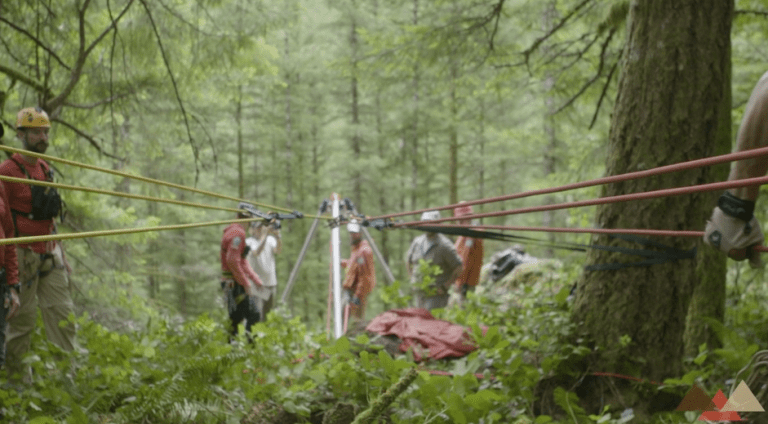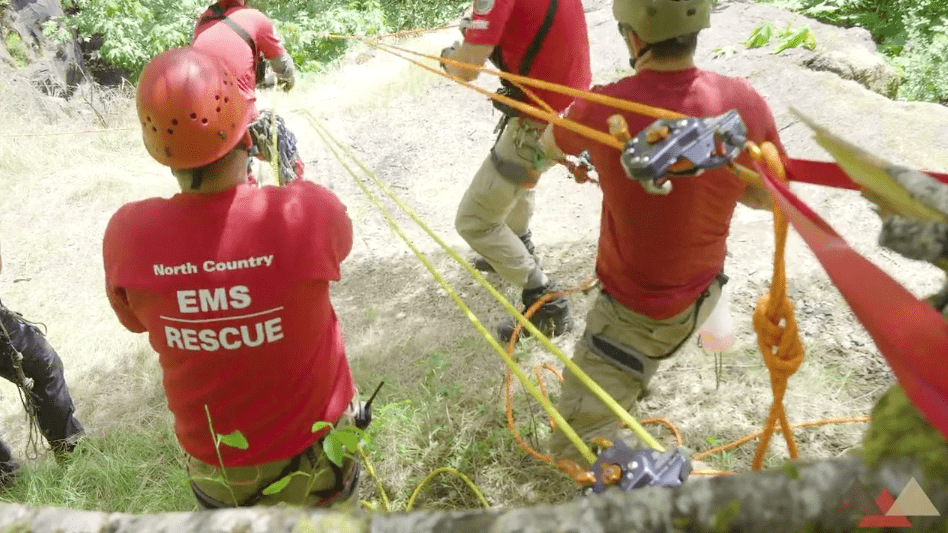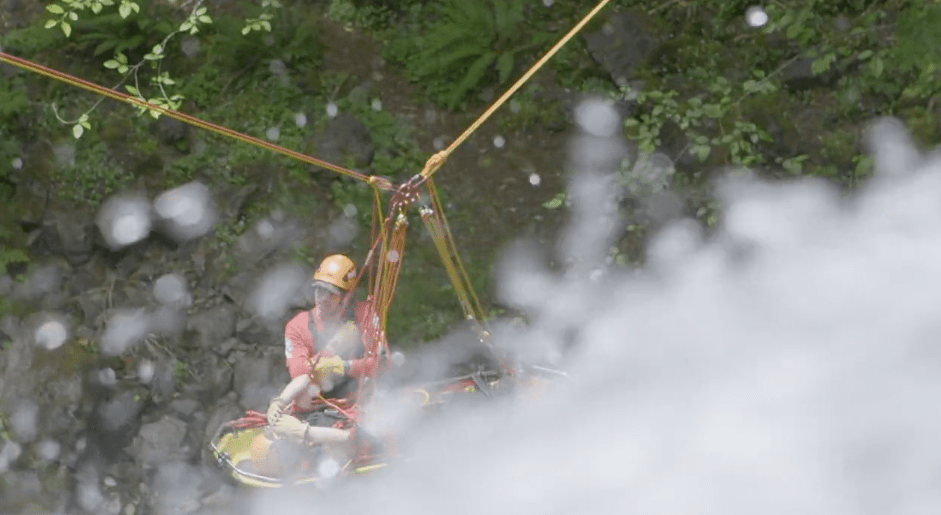Two Tension Rope Systems
Background: As a rescue community, it is accepted as best practice to employ a two-rope system in order to best protect life safety. Most traditionally up to this point the dedicated main dedicated belay (DMDB) has been common practice. This employs a technique in which the full amount of the load is supported with a single main line, with the safety being in the form of a non-tensioned belay line. This was commonly achieved through the use of a tandem prusik belay. This system, does and always will meet the belay competency requirements set forth by the BCCTR that were established during their initial drop testing. As time progressed forward, technology in the rescue community did as well.
The two-tension rope system (TTRS) began to take hold of what is considered to be best practice. This concept was most recently brought to the forefront through testing by Kirk Mauthner, and distributed by ITRS presentations in 2014, and 2016. A two-tension rope system has many variants, but in its simplest, and most common form utilizes two separate ropes, both which are under tension sharing the load.
This concept challenges many of the established practices that have been around for generations of rope technicians. To paraphrase the definition of a belay accepted by many, it is a secondary rope system that is operated by a competent person utilizing an acceptable device that stands at the ready to receive the capacity of the load should there be a main line failure. All without ever seeing any tension prior to the belay being activated.
The two-tension rope system requires a paradigm shift in mentality from seeing a rope system with a dedicated main and dedicated, non-tensioned belay, to a rope system that has two main lines both under tension and providing the necessary redundancy for the other.
Why Now: Never before in rope rescue has the two-tension rope system been so accessible to reap the benefits from it. This is largely in part because of devices like the MPD becoming commonplace across the country. By using devices such as the Petzl ID or the CMC MPD, the operator is able to operate a rope system with an auto stopping feature. This allows for much greater control over the descent of a load than ever before. It also allows two operators to work side by side, and communicate easily to lower a load at the same rate of speed by using like devices.
(A Two Rope Offset using Two Tension Systems on both near and far sides.)
The Benefits: The Two-tension rope system has had marked benefits in the rescue world that have been proven through testing. Drop tests conducted by Kirk Mauthner demonstrate several of these. Perhaps the biggest benefit in the name of safety, is eliminating the increased fall distance generated by a non-tensioned belay rope. If using a DMDB rope system, and a main line failure occurs, the totality of the load is transferred to the belay system in the form of a shock load. It has been demonstrated that the peak force on the belay components during such events can reach 3x the load. That is a massive amount of force being harshly distributed to the only surviving components of the rope system.
What drop testing found, was that during the process of shock loading the non-tensioned belay line, a large amount of rope stretch is introduced in to the belay rope. This rope stretch can be detrimental in many ways. Imagine riding as the attendant on a litter when suddenly you are dropped potentially 15ft because of the rope stretch of the shock loaded belay line. This obviously is dependent on the total weight of the load, and the amount of rope in service at the time of failure; however this will almost assuredly result in injury received by the attendant.
The two-tensioned rope system decreases this fall distance substantially. Due to the fact that both lines are sharing tension, should one fail there is a greatly diminished slam factor on to the remaining line because that line is already carrying 50% of the load (ideally). If we were to incorporate load cells in to both ropes in a two-tensioned system, it would be rare that at all times both are receiving exactly half the load, but even a small amount of tensioned introduced in to a second rope will aid in cutting fall distance. The CMC MPD is a perfect device to be used for this application because in the literature for the product it lists the capability to support a full rescue load. This means, that if both devices for a two-tensioned system are MPDs, and one were to fail, the surviving MPD will be capable of receiving the entirety of the load.
Another benefit of a two-tensioned system using a device such as the MPD is the simplicity of lowering, and raising. Because the MPD is not only a descent control device with auto stopping functionality, but also a full efficiency pulley, it has never been easier to transition from a lowering operation to a raising operation and back again.
In the past techniques such as the rack pulley mariners (RPM) were used to accomplish this task. Doing this required a much greater amount of equipment and the addition of several steps. The two-tensioned system with MPDs can easily make this transition simply by allowing the MPD to capture the load when lowering is stopped, and rigging the desired pulley system right through the MPD. In the case of the TTRS, both lines can be converted to pulley systems, allowing greater mechanical advantage hauling the load up with minimal effort.
Many teams have also noticed a benefit in the way of training by employing the TTRS specifically with the MPD. Whereas in the past, each team member had to be totally proficient with the operation of brake racks, load releasing hitches etc, the MPD has simplified the operation of lowering devices. The MPD still requires proper training before use, however a greater number of operators are able to grasp the key components of lowering systems at a faster rate.
The Human Factor: It is likely that the biggest argument against the TTRS lies in the potential for human error. When using a device like the MPD, the operator is required to manually release the T handle in order to stop the rope from moving through it. This means, that should one rope fail, the operator of the second line must consciously release the handle in order to prevent a free fall event. The question must be asked if this speculation is delving too far down the rabbit hole of redundancy.
If we are willing to bring in to question a competent rescue technician’s ability to operate the device they are trained to use, surely we must also question the integrity of the rest of our systems. Where we tie an anchor… we should tie two, when we tie a knot… we should add a second; one can see where this logic takes us.
The fact is, every belay system is capable of being overridden by a non-attentive operator. A tandem prusik belay can be improperly operated introducing a massive amount of slack in the system. An MPD can be improperly operated. A 540 belay can be reeved incorrectly. The answer to all of this is proper training, and evaluation of the team members responsible for operating these systems.
Conclusion: The two-tensioned rope system has been tested and proven to perform better in many circumstances than a dedicated main dedicated belay rope system. Safety is improved, efficiency is increased, and training is simplified. It is the best practice of Rigging Lab Academy to teach the two-tensioned rope system as the predominant method to conduct our operations.
[thrive_leads id=’51985′]












13 thoughts on “Two Tension Rope Systems: The Time Has Come”
I love it when people come together and share opinions, great blog, keep it up.
This is a topic close to my heart cheers, where are your contact details though?
Those are yours alright! . We at least need to get these people stealing images to start blogging! They probably just did a image search and grabbed them. They look good though!
454644 478669Nice read, I just passed this onto a colleague who was doing a little research on that. And he just bought me lunch as I found it for him smile So let me rephrase that: Thank you for lunch! 929495
695059 357045dress shops that offer discounts are quite common in our spot and i always shop at them,. 810279
Thanks for your posting. One other thing is individual states in the United states of america have their own laws of which affect house owners, which makes it very hard for the the nation’s lawmakers to come up with a whole new set of rules concerning foreclosed on homeowners. The problem is that each state features own regulations which may have impact in an undesirable manner in terms of foreclosure policies.
Hey there! I know this is somewhat off topic but I was wondering which blog platform are you using for this website? I’m getting tired of WordPress because I’ve had issues with hackers and I’m looking at alternatives for another platform. I would be great if you could point me in the direction of a good platform.
490302 994875Interested in start up a online business on line denotes revealing your service also providers not only to humans within your town, nevertheless , to numerous future prospects which are cyberspace on numerous occasions. pays day-to-day 847139
545599 962026really nice post, i undoubtedly adore this wonderful web site, carry on it 174663
This is one awesome article post. Much obliged.
767517 957279Hi there! Fantastic stuff, please do tell me when you lastly post something like that! 471543
Thanks a bunch for sharing this with all of us you actually recognize what you are speaking approximately! Bookmarked. Kindly also discuss with my web site =). We will have a hyperlink exchange agreement between us!
I truly appreciate this post. I¦ve been looking all over for this! Thank goodness I found it on Bing. You have made my day! Thx again
Comments are closed.